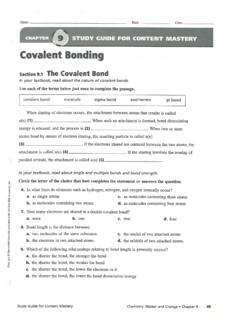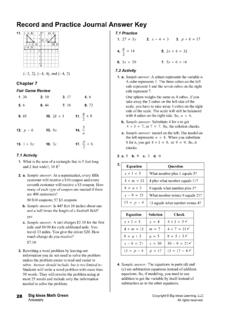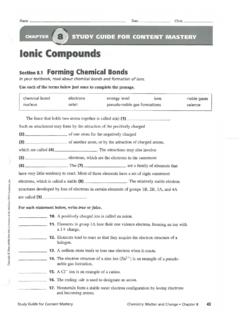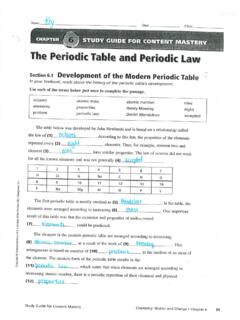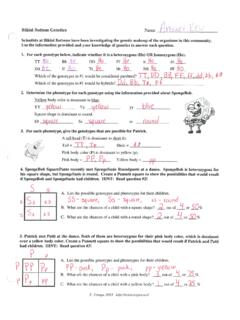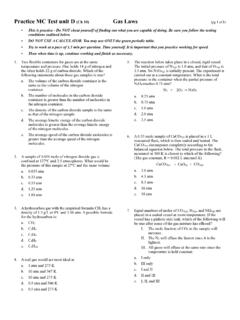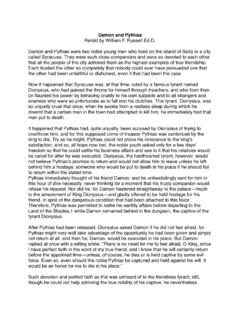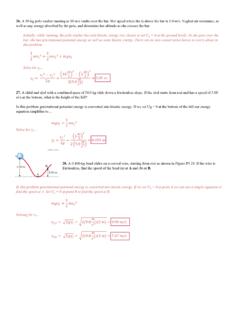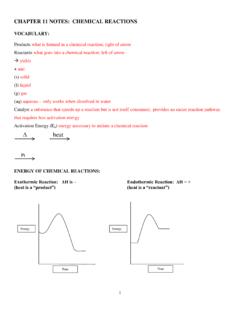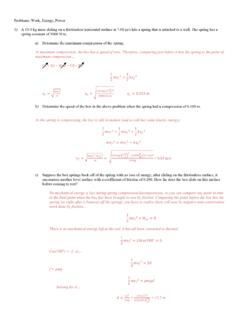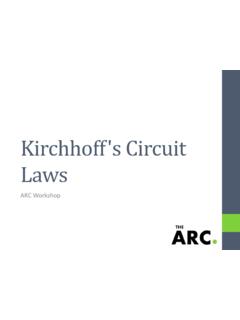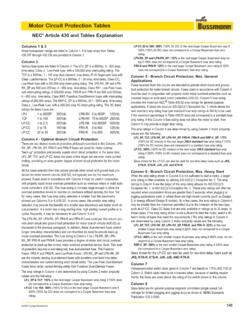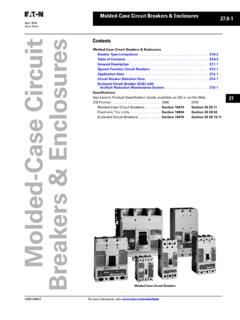Transcription of Circuit A Circuit B - Livingston Public Schools
1 +-RRR+-RCircuit ACircuit BI = 3 ACIRCUITS WORKSHEET 1. Determine the equivalent (total) resistance for each of the following circuits below. 2. Determine the total voltage (electric potential) for each of the following circuits below. 13V 12 V 3. In a series Circuit there is just one path so the charge flow is constant everywhere (charge is not lost or gained). CircuitB was made by adding 2 more identical resistors in series to circuitA a) How is the charge flow out of the battery (and back into it) affected by adding more bulbs in series? Charge flow or current decreases as total resistance increases b) If the resistors were light bulbs, how do you expect the brightness of the bulbs to be affected by adding more bulbs in series?
2 Brightness gets dimmer since less current or charge passing through each bulb AND smaller voltage drop across each bulb (the voltage gain at the battery is now distributed among 3 bulbs as opposed to just one). c) How is the brightness in the 2 circuits related to charge flow or current? The brightness is directly related to current since the less charge flowing through each bulb each second, the less energy/charge is lost and converted to light d) How does the current in Circuit B compare to Circuit A? Circuit B has three times the total resistance (same V) so current supplied by battery drops three fold. Circuit B would have only 1A of current. 75221eqeqRRRR 14752321eqeqRRRRR+-R1R2R36A 2A 2A 2A 2A e) How is current (I) related to the resistance of the Circuit ?
3 The current is inversely related to the total resistance of the Circuit (Ohm s Law) f) If the resistance of a Circuit is quadrupled, by what factor does the current change? 1/4th g) Fill out the table for the Circuit diagramed at the right. h) Is there a relationship between resistance and voltage drop in a series Circuit ? If so, state it. Ohm s Law: V = IR c) If the resistors were light bulbs, explain in terms of charge flow (current) and energy per charge (voltage) which bulb would be brightest / dimmest. The brightness of the bulb is related to - V (amount of electrical energy lost and converted to heat/light) and - I (the higher the current through the bulb, the more charge per sec converting energy to light) In this case, the current through each resistor is the same, so V determines the brightness.
4 Since the voltage drop across the 30 resistor is greatest, it would be the brightest bulb. Conversely, since the voltage drop across the 10 resistor is least, it would be the dimmest bulb. 4. In a parallel Circuit , there is more than one loop or pathway so charge flow gets split up or recombined at junction points. Therefore current is not the same at every point in the Circuit a) How does the current through the one resistor in Circuit A, compare to the current through each resistor in Circuit B? (Use Kirchoff Loop rule on Circuit B to look at the current in each path.) The current through each resistor in Circuit B is the same as the current through the resistor in Circuit A (I = V/R.
5 V across R in Circuit B is same as Circuit A) b) How does the sum of the currents through the three bulbs in Circuit B compare to current from the battery in Circuit A? Since the current across each bulb in Circuit B is the same as in Circuit A and there are three pathways, the sum of the currents in B is 3x current in Circuit A Circuit Position Voltage (V) Current (A) Resistance ( ) Power (W) 1 2 3 Total 60 I = ____+-3 6 VCircuit B+- Circuit A6V3 3 3 I = ____ +-R1R2R3c) How is the current out of the battery (and back into it) affected by adding resistors in parallel? Explain Charge flow out of the battery would increase since there are more pathways for current to go d) If the resistors were light bulbs, how does the brightness of each bulb in Circuit B compare to the brightness of the single bulb in circuitA,?
6 The brightness of the bulb is related to - V (amount of electrical energy lost and converted to heat/light) and - I (the higher the current through the bulb, the more charge per sec converting energy to light) In this case, the voltage drop across each resistor in Circuit B is same as voltage drop across R. The current through each resistor in Circuit B is also the same as the current through R in circuitA. Therefore, the brightness of the bulbs in B would be same as brightness of bulb in A e) How is the resistance of a Circuit affected by adding additional pathways? Total Resistance decreases (because more pathways for the charge to flow) f) Fill out the table for the Circuit diagramed at the right.
7 Circuit Position Voltage (V) Current (A) Resistance ( ) Power (W) 1 2 3 Total (Vbat/Ibat) g) How does the voltage drop across each branch in a parallel Circuit compare? The voltage drop across each branch is the SAME in a parallel Circuit . h) If the resistors were light bulbs, explain in terms of charge flow (current) and energy per charge (voltage) which bulb would be brightest / dimmest. The brightness of the bulb is related to - V (amount of electrical energy lost and converted to heat/light) and - I (the higher the current through the bulb, the more charge per sec converting energy to light) In this case, the voltage drop across each resistor is the same, so I determines the brightness.
8 Since the current through the 10 resistor is greatest, it would be the brightest bulb. Conversely, since the current through the 30 resistor is least, it would be the dimmest bulb. Notice that the resistance doesn t determine brightness since the 30 bulb was brightest when connected to the others in series. 5. Consider the Circuit at right. Assume the resistors are identical. a) Rank the resistors according to the flow of charge through them. Current is drawn from the battery and then splits at the branch point. Since charge is conserved in the Circuit (Kirchoff s junction rule), the current going into the junction is equal to the sum of the currents coming II1I2I3I4 ReqI12 Vout.
9 Since R2 and R3 are identical, the current splits equally down the R2 and R3 pathway (I2 = I3). At the next branch point, the current recombines to the original total current and this is what goes through R1. I2 = I3 < I1 b) Imagine that the resistors in parallel (R2 and R3) were a single resistor. How would the combined equivalent resistance of R23 compare to the resistance of R1? The resistors in the box are in parallel so the equivalent resistance is The equivalent resistance is half of R1 c) Now let R1 = 10 , R2 = 20 and R3 = 30 Fill out the table for the Circuit Questions 6 and 7 refer to the following: The diagram to the right represents an electric Circuit consisting of four resistors and a 12-volt battery 6) What is the equivalent resistance of the Circuit shown?
10 7) What is the current measured by ammeter A shown in the diagram? KLR on loop with 12V battery and 6 resistor KLR Circuit Position Voltage (V) Current (A) Resistance ( ) Power (W) 1 2 3 Total (current thru battery) 22 (Req) 2/2111 RRRRRR eqeq 31236361218136112161111114321eqeqRRRRRRA IIVVVVbat2)6(1212001166 8) A lamp requires ampere of current to operate. In which Circuit below would the lamp operate correctly when switch S is closed? It would only operate in C. In A and D, closing the switch would introduce a pathway of zero resistance. ALL of the current would go down the path of no resistance leaving NO current passing through the lamp (the Circuit would be short circuited).
